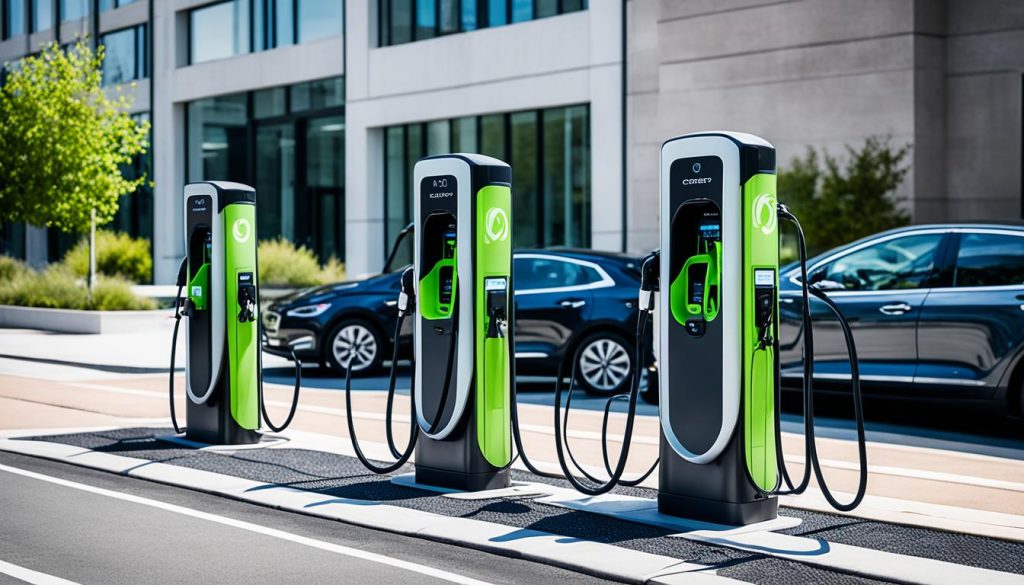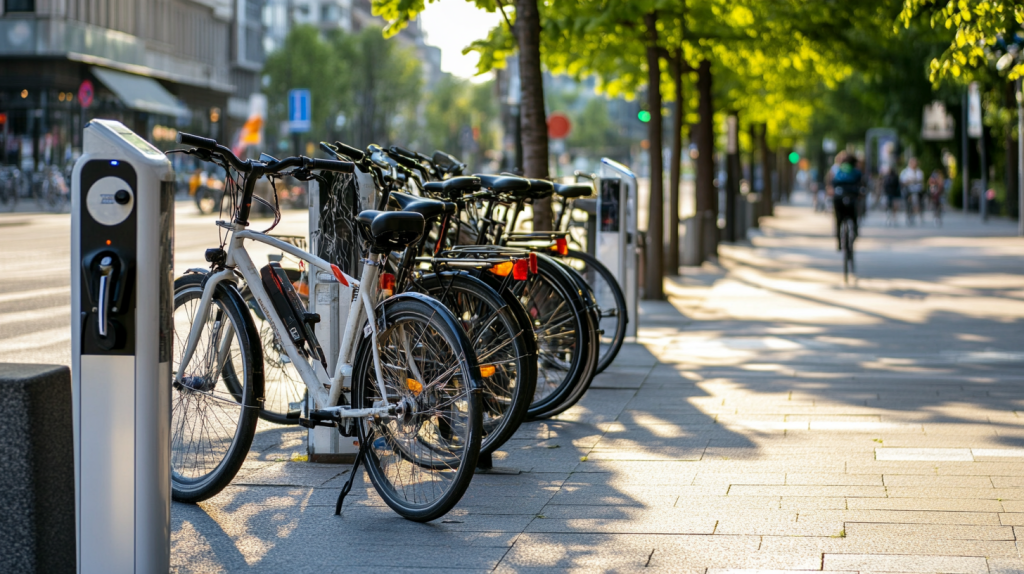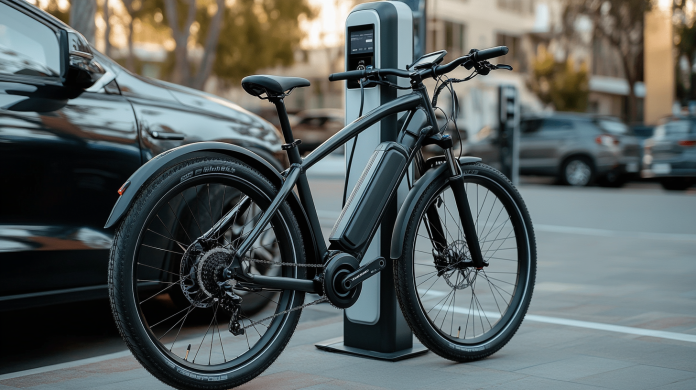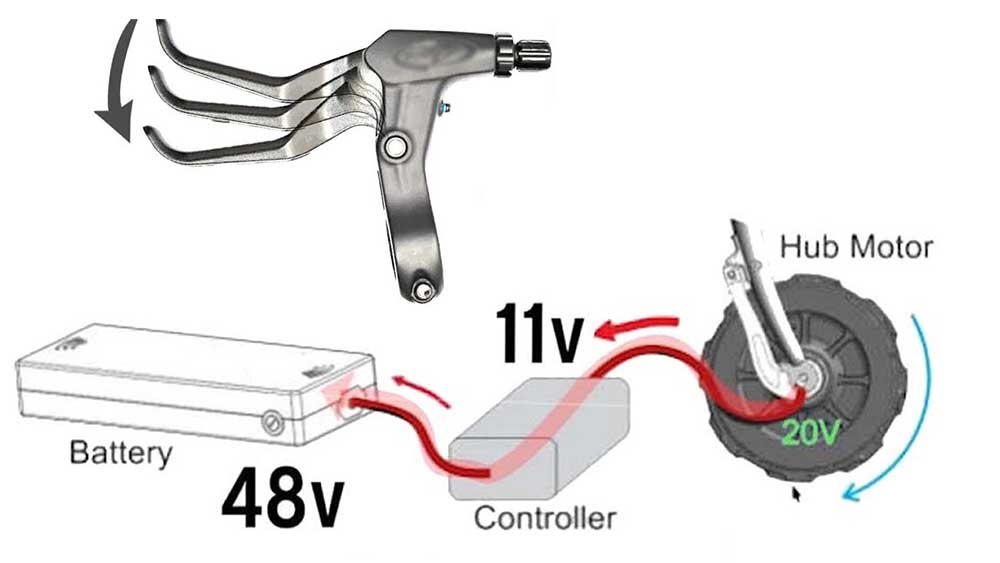Electric bikes are becoming more popular in the USA, raising a key question: Can you charge electric bikes at car charging stations? This idea is exciting for e-bike fans and EV owners. At ebikesus.com, we’re exploring this topic to find out what’s possible and what to watch out for.
Using public EV charging spots for e-bikes is becoming more common. A test with a Bosch-powered Gazelle C380+ HMB e-bike showed good results. With a special adapter, the bike’s battery charged 50% in two hours at a Volta L2 EV station.
This breakthrough could change how we charge e-bikes. But, we must be careful. Safety and compatibility issues are big concerns. Having the right gear and knowledge is key to safely charging your e-bike at car stations.
Table of Contents
Key Takeaways
- Charging e-bikes at car stations is possible but requires careful consideration
- Specialized adapters are necessary for compatibility
- Safety is paramount when using EV infrastructure for e-bikes
- Charging time can be significantly reduced using car charging stations
- Public EV charging networks could potentially support e-bike charging in the future
Understanding E-Bike Battery Technology
E-bike batteries have evolved a lot in recent years. The switch from Lead Acid to Lithium-ion has changed bike battery charging. Now, e-bikes have a great range and performance, thanks to new battery technology.
Lithium-ion Batteries in E-Bikes
Lithium-ion batteries power modern e-bikes. They’re light, strong, and last a long time. A lithium battery pack weighs 6 to 8 lbs and gives about 20 miles of range. This is a big jump from older batteries.

Comparing E-Bike and Electric Car Batteries
E-bike and electric car batteries both use lithium-ion tech but are different. Car batteries are bigger and have better cooling systems. E-bike batteries are simpler but still powerful. A 500 watt-hour e-bike battery can give 250 watts for 2 hours or 500 watts for 1 hour.
Charging Requirements for E-Bikes
E-bike charging is easier than ev charging for e-bikes. Most e-bikes use regular electrical outlets. A lightweight e-bike uses about 17 Wh per mile on flat roads. So, you can recharge it after a 20-mile ride easily.
When picking an e-bike, think about the battery size. A big battery can make the bike hard to handle and carry. For most riders who go less than 20 miles, a light e-bike with a small battery is best.
As charging solutions for micromobility grow, we’re seeing more places to charge e-bikes in cities. This makes it easy to keep your e-bike charged and ready to go.
Types of Car Charging Stations
As electric vehicle charging grows, you’ll see many types of charging stations. These stations are key to public and shared charging systems. Let’s look at the three main types you might find.
Level 1 Chargers: Standard Electrical Outlets
Level 1 chargers use standard 120-volt outlets found in homes. They’re the slowest but great for overnight charging at home. They add about 2-5 miles of range per hour of charging.
Level 2 Chargers: Faster Charging with 240-volt Outlets
Level 2 chargers need 240-volt outlets and are often in public areas and workplaces. They’re faster than Level 1, adding 10-20 miles of range per hour. Many EV owners put these in their homes for faster charging.
DC Fast Chargers: High-power Public Stations
DC Fast Chargers are the fastest in public charging. They can give 60-80 miles of range in just 20 minutes. These are perfect for long trips and are part of the growing EV charging network in the U.S.
| Charger Type | Voltage | Charging Speed | Typical Locations |
|---|---|---|---|
| Level 1 | 120V | 2-5 miles/hour | Homes |
| Level 2 | 240V | 10-20 miles/hour | Homes, Workplaces, Public Spaces |
| DC Fast | 480V+ | 60-80 miles/20 min | Public Charging Stations |

Knowing about these charging options helps you plan your trips and pick the best charging method for your electric vehicle. As the EV market grows, expect to see more diverse and efficient charging solutions.
Compatibility Issues Between E-Bikes and Car Chargers
E-bike batteries don’t easily fit into car charging stations. The power needs and connectors for e-bikes and electric vehicles are very different. This makes it hard to charge e-bikes at EV stations.
Car chargers give out a lot of power, which could harm e-bike batteries. The connectors on car chargers also don’t match those on e-bikes, so adapters are needed. In a test with a Bosch-powered e-bike, the station showed “Plugged in…” but not “In use” like for cars.

Getting EV charging to work with e-bikes is a big problem for riders. Even though more charging spots are being added, most are for electric cars, not e-bikes. This means e-bike users have few places to charge on long trips.
| Aspect | E-Bikes | Electric Cars |
|---|---|---|
| Charging Time | 3-8 hours | 30 minutes – 12 hours |
| Power Output | Low (100-500W) | High (3-350kW) |
| Connector Type | Varies by brand | Standardized (CCS, CHAdeMO) |
Cities are looking into special e-bike charging stations and battery swap places. These ideas aim to make charging e-bikes easier and lessen worries about running out of power.
Safety Concerns When Charging E-Bikes at Car Stations
Charging your e-bike at a car station might seem easy, but it’s not without risks. Keeping your e-bike safe while charging is crucial. Let’s look at the dangers and steps to take.
Risks of Overheating and Battery Damage
E-bikes use lithium-ion batteries, like the 48V 20Ah Samsung battery in the Macfox X2 off-road electric bike. These batteries need lower power than electric cars. Charging them at car stations without the right setup can cause overheating or damage.
Importance of Proper Adapters
To charge safely at car stations, you need the right gear. A 6A charger for 220-240V can work with Level 2 EV stations. But, you must watch it closely and follow charging rules.
Potential Legal and Liability Issues
Charging e-bikes at car stations can lead to legal problems. If the station isn’t made for e-bikes, you could be liable for accidents or damage. Always check the laws and station rules before charging.
| Charging Method | Safety Level | Convenience | Legal Risk |
|---|---|---|---|
| Dedicated E-bike Charger | High | Medium | Low |
| Car Charging Station | Low | High | High |
| Battery Swap Stations for E-bikes | High | High | Low |
Car charging stations might seem convenient, but battery swap stations are safer for e-bikes. They offer both ease and safety, ensuring your e-bike charges right without risking damage or legal trouble.
Alternative Charging Solutions for E-Bikes
E-bike riders are always looking for easy ways to charge their bikes. Car charging stations might look appealing, but there are safer and better options made just for e-bikes.
Battery-swapping stations are becoming popular in cities. They let you swap a dead battery for a new one quickly, cutting down on waiting time. In New York City, companies like Swobbee and Popwheels are testing these services. They help delivery workers and commuters keep their e-bikes charged.
Portable power banks are a handy choice for e-bike riders. These small devices can charge your bike’s battery anywhere, giving you peace of mind on long rides. Some even have solar panels for charging the green way.
Solar charging options are getting easier to find. Innovative projects like the wireless charging stations in Amsterdam show how e-bikes can be charged sustainably.
If you prefer charging at home, portable chargers are a good pick. These chargers are made by the bike’s manufacturer. They ensure safe and efficient charging, perfect for your bike model.
| Charging Solution | Pros | Cons |
|---|---|---|
| Battery Swapping Stations | Quick, convenient for urban use | Limited availability, subscription may be required |
| Portable Power Banks | Flexible, great for emergencies | Limited capacity, may add weight to carry |
| Solar Charging Solutions | Eco-friendly, potentially free energy | Weather-dependent, initial setup cost |
| Home Portable Chargers | Safe, manufacturer-approved | Requires access to power outlet, slower charging |
As more people use e-bikes, these charging options are getting better to meet our needs. This means you can keep riding with power, wherever you go.
Charge Electric Bikes at Car Charging Stations: Practical Considerations
Charging your electric bike at car charging stations can ease range anxiety. As more charge points become available, this option is getting better. Let’s look at how to use car chargers for your e-bike.
Necessary Equipment for Adapting Car Chargers
To charge your e-bike at a car station, you’ll need:
- A compatible charger
- An adapter (e.g., J1772 to NEMA 5-15/5-20 EV Charger Adapter)
- Your e-bike’s charging cable
Step-by-Step Charging Guide
- Locate a compatible charging station
- Connect your adapter to the station
- Plug your e-bike charger into the adapter
- Connect the charger to your e-bike
- Monitor the charging process
Impact on Charging Time and Battery Life
Charging your e-bike at car stations can change how long it takes and affects battery life. Smart grid tech might make this better in the future. Here’s how different charging methods compare:
| Charging Method | Charging Time (500Wh battery) | Impact on Battery Life |
|---|---|---|
| Standard Home Charger (2A) | 6-7 hours | Minimal |
| Fast Home Charger (4A) | 3-4 hours | Slight reduction |
| Car Charging Station | 1-2 hours | Potential faster degradation |
Ebike fast charging is handy but might shorten your battery’s life. Always stick to the maker’s advice for the best battery care.
The Future of E-Bike Charging Infrastructure
The electric bicycle charging infrastructure is changing fast. More people are using e-bikes, so they need easy ways to charge them. Bike-energy, a leader in Europe since 2008, is leading this change.

Development of Dedicated E-Bike Charging Stations
New charging stations for e-bikes are appearing in the U.S. Massachusetts is funding these stations for everyone. Oregon is adding chargers to the West Coast Electric Highway. These efforts help extend ebike range and encourage green travel.
Integration with Existing EV Infrastructure
Cities like Pittsburgh are testing hubs that charge e-bikes and scooters. This could connect with electric car charging spots, creating a wide network of charging options.
Innovations in Universal Charging Solutions
Soon, we might see chargers for both e-bikes and electric cars. Smart grids could manage power better. Ebike battery swap stations are also becoming more popular.
| Aspect | Current Status | Future Potential |
|---|---|---|
| Charging Cost | $21.17 yearly average | Potential decrease with solar integration |
| Charging Network | Limited, no nationwide map | Extensive, integrated with EV infrastructure |
| Power Source | Grid-dependent | Solar and smart grid integration |
Even with challenges like standardization and “charging deserts,” the future of e-bike charging is bright. With more innovation and investment, we’ll see a better and easier electric bicycle charging network soon.
Conclusion
The future of sustainable mobility looks bright, with e-bikes at the forefront. While electric cars get a lot of attention, e-bike sales are expected to double in the next five years. This growth means we need better charging options and affordable solutions.
E-bikes are a green choice compared to traditional transport. They can go up to 25 mph and travel 20-50 miles on one charge. This makes them perfect for city trips and college life. Unlike cars, e-bikes save money on gas, insurance, and parking.
As more people choose e-bikes, charging spots are becoming more common. Companies like Uber are setting up charging hubs in cities. New portable chargers make it easy to charge on the go. These changes, along with good charging habits, will help more people use e-bikes.
The e-bike movement is growing fast. With more investment in infrastructure and tech, these bikes will change city travel. Get ready for a cleaner, more efficient way to get around with electric bikes in the USA.






